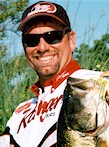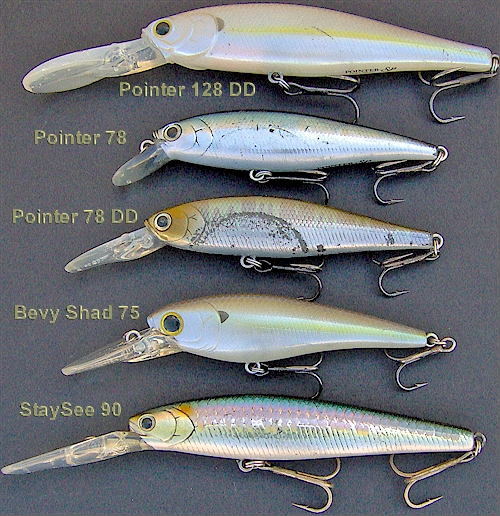Ripbaits According to Gary Dobyns
Written by Russ Bassdozer
Few names in history evoke as much fear as "Jack the
Ripper", a notorious figure that preyed on London in the
late 1880's. Over 100 years later, the name of Gary Dobyns evokes
fear too - in those going up against Gary and his ripbaits in
Western tournaments. That's because Gary Dobyns has won well over
one million off his competitors, a good chunk of it by ripping
them with hard plastic-lipped ripbaits.
 Q:
Gary, you've recently had some newsworthy success with ripbaits.
I'd like to ask you more about ripbaits today Gary. To set the
scene, you rip with a 7 foot Loomis CBR845 baitcasting rod, 6:1
reel and primarily 10 lb line, either monofilament or Yamamoto
Sugoi fluorocarbon which lets you get a foot or two deeper than
mono. On the rod, does it serve any other purpose - crankbaits,
topwater or whatever? Q:
Gary, you've recently had some newsworthy success with ripbaits.
I'd like to ask you more about ripbaits today Gary. To set the
scene, you rip with a 7 foot Loomis CBR845 baitcasting rod, 6:1
reel and primarily 10 lb line, either monofilament or Yamamoto
Sugoi fluorocarbon which lets you get a foot or two deeper than
mono. On the rod, does it serve any other purpose - crankbaits,
topwater or whatever?
GD: Russ, this is the only
rod model I rip with, using 10 lb test for ordinary ripbaits, and
12 lb test for larger ripbaits. I also throw a lot of small
crankbaits with this rod. However, I do not throw big cranks with
this rod. For larger crankbaits, I step up to the Loomis CBR847
rod.
The ripbait rod (CBR845) is also perfect for small poppers.
So, the G. Loomis CBR845 crankbait rod is universal in that it
can cover ripbaits, small crankbaits and small topwater poppers
in one rod model.
Q:
Gary, I know you rip more than 90% of the time with Lucky Craft
baits. So let's limit this article to the Lucky Crafts you use
most often. What can you tell us about each of the Lucky Craft
ripbaits you use, Gary?
GD: Russ, there's nothing
specific about any individual model. These are the ones I tend to
use more often:
- Flash Minnow 110SP 4-1/2" 5/8 oz 2-3 ft
- Pointer 128SP 5" 1 oz 3-5 ft
- Pointer 78SP 3" 3/8 oz 4-5 ft
- Pointer 78DD 3" 3/8 oz 7-8 ft
- Bevy Shad 75SP 3" 3/8 oz 7-8 ft
- Staysee 90SP 3-1/2" 7/16 oz 8-10 ft
I use the deep divers more often earlier in the year, because
the fish are deeper then, and the two deepest models are the
Staysee and the Bevy Shad. As fish come up real shallow, the
Flash Minnow and the Pointer 78 are the shallowest models. The
Pointer 128, being a big bait, I use it for brawling with big
shallow largemouth.
What causes me to use one model or another is that I am trying
to reach different water columns where fish are stacked. The
difference of getting my ripbait a couple of feet deeper or
shallower is what makes the difference between getting bit or
not.
Q:
Gary, sometimes a bait gets categorized as a smallmouth killer or
a spotted bass killer, or other species-specific usage. Do you
think ripbaits have a specific appeal to smallmouth, spotted bass
or largemouth?
GD: You've caught me by
surprise with that question, Russ. Honestly, I've never made a
species distinction when it comes to ripbaits. Ripbaits have
universal appeal to all three bass species. Using ripbaits, I've
never noticed a difference in catchability between largemouth,
smallmouth or spotted bass.
Q:
Gary, some anglers mention having a good ripbait bite first thing
in the morning, and then have it fade out and die on them by
mid-morning. Is that something you've seen about the ripbait
bite? Is the ripbait bite similar to what many have experienced
with an early morning topwater bite, that it's usually good at
first light, and shuts down once the sun hits the water?
GD: In spring and winter,
the ripbait bite can last all day. By late spring and early
summer, an early morning ripbait bite can be very true.
Especially in clear warm water, the ripbait bite is easier in low
light, a lot better early in the morning and late in the evening.
Once the sun is overhead and water is clear, the ripbait bite can
become harder. This is basically true of any reaction bait bite.

Q:
Gary, what would you say is the biggest error you see anglers
make with ripbaits?
GD: There are two things:
- Not tuning them. Anglers should test their ripbaits in a pool
or clear water. They should swim perfectly straight on a steady
retrieve. Otherwise, when you rip them, they'll roll up on one
side or another, and you won't get the depth or the action you
need out of the ripbait.
- maintaining too much line tension. Between rips, many anglers
keep too much line tension, which keeps the lure creeping forward
ever so slowly due to line tension. When a ripbait pauses, the
fish needs to see a dead still lure. I move the rod tip back
toward the bait to give a little slack after every rip, which
causes the lure to come to a dead stop.
Q:
Overall, what action are you trying to create with a ripbait,
Gary? What impression are you trying to make on the bass with a
ripbait?
GD: I am creating a
rip-pause action. Actually, the rip is more like a pop (how you
would pop a popper is a good idea for those who haven't ripped
yet) - and always the pause, which is when you get bit. I'll mix
the number of pops from one to three - pop, pop, pop, pause, pop,
pause, pop, pop, pause. I deploy an erratic action.
The impression I am trying to make on a bass is that the
ripbait is crippled or injured. Again, you can think of this as
the same sort of impression we often try to make on the surface
with a popper.
Q: With
the rip component of the action you create, do you vary the rip
for different seasons?
GD: Not really, Russ, I
usually rip it good. Again, think of them as pops. In really cold
water, I won't rip it as hard as I normally rip it the rest of
the year. Speaking of very cold water, there is a misconception
that ripbaits don't work well in water temperatures below 55
degrees. That's not true. There's one fishery that's typically 44
degree water in winter, and I rip them.
Q: With
the pause component of the action you create, do you vary the
pause for different seasons, Gary?
GD: In winter, all the
prey fish out there are colder, therefore slower. With predator
fish, nothing is as aggressive in winter as in spring, summer or
fall. Most of the time, I will pause 2-3 seconds and pop it
again. Just in winter, I may go slower on the pause - anywhere up
to 5-7 seconds. That's an awful long time for a fisherman to
wait! Sit here and count it to yourself now.
Q: Do
you look to develop a cadence for the day? That is, once you
catch a few on a certain sequence of pops and pauses, do you find
all your fish going for that same sequence of popping-pausing -
or do you catch fish on a diversity of cadences during the day,
Gary?
GD: That's a good
question, Russ. Once I rip a few fish for the day, I will get
tuned into that way of creating a certain retrieve for the rest
of the day. Once I've gotten results with a certain cadence, I
will get into it, and stick with it the rest of the day. It's the
same thing, for example, with a buzzbait. Some days they want a
buzzbait slow, the next day fast. It's a trial-and-error method
to begin the day, then you discover what they want from you, and
lock yourself into it.
Q:
Gary, I speak for every reader when I thank you for sharing your
insights on ripbaits with us. Are there any other points you'd
like to mention before we say goodbye, sir?
GD: Ripping is an easy
technique, and it can be very easy when bass do not want to feed,
but are just acting aggressive. Ripping evokes an aggressive
predator instinct. Also, it can be a big fish bait.
Again
thank you, Gary.
GD: You are welcome, Russ
and readers.
|
